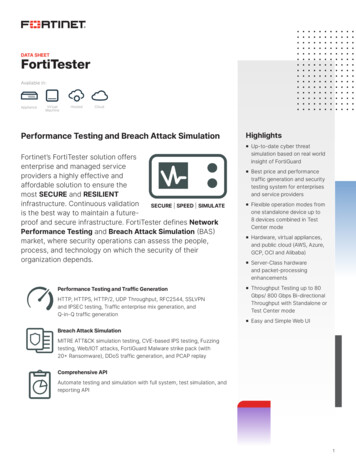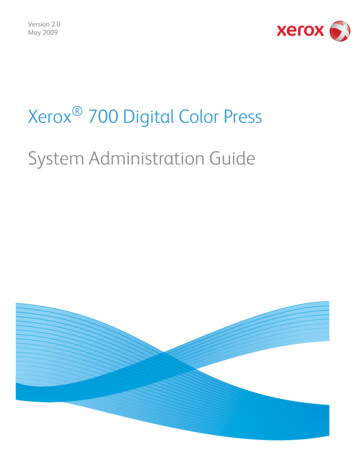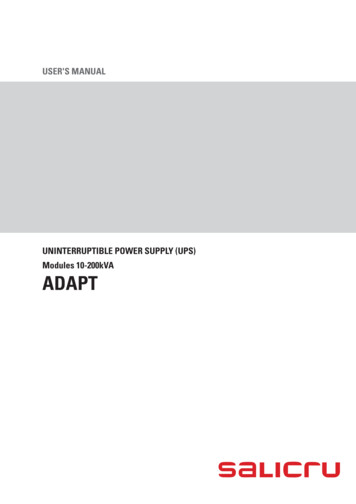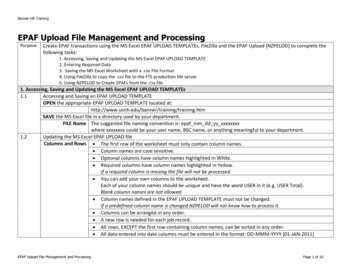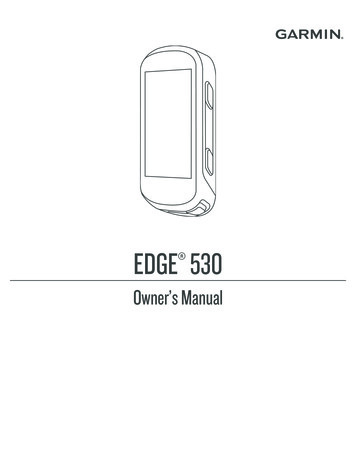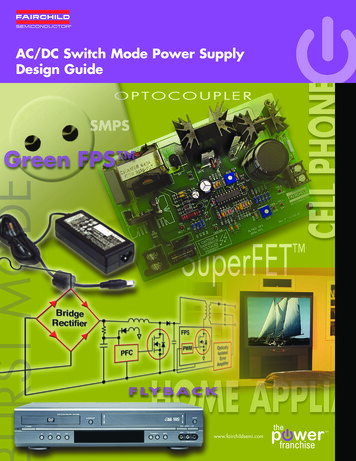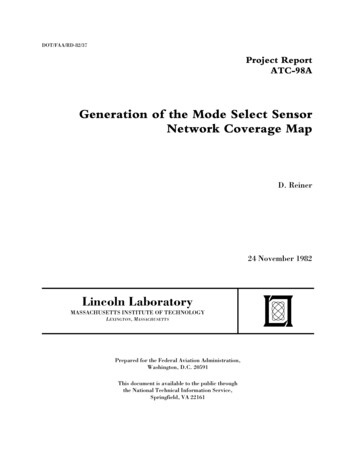
Transcription
DOT/FAA/RD-82/37Project ReportATC-98AGeneration of the Mode Select SensorNetwork Coverage MapD. Reiner24 November 1982Lincoln LaboratoryMASSACHUSETTS INSTITUTE OF TECHNOLOGYLEXINGTON, MASSACHUSETTSPrepared for the Federal Aviation Administration,Washington, D.C. 20591This document is available to the public throughthe National Technical Information Service,Springfield, VA 22161
This document is disseminated under the sponsorship of the Departmentof Transportation in the interest of information exchange. The UnitedStates Government assumes no liability for its contents or use thereof.
3fL7qlhwz o—k3 *tisketionH*TechnicalR.anofiOocumnntationPat.cm* M.DoT/FAA/RDa2/375,R, Oam24 November 1982& hmO,wti.ti wrti d S*hner.!ion of the Mode Select %“ r Network Gverage Map8. Pa-s)Reiner)avidhmOmekmb.ATG98AM.to. W,ti U* kd -Projmt No. 052-241 11. -aw G,,ti8’,DOT-FA72.WAI-261fia acbu tts Institute of TechnoloW.incaln bboratory‘.0.Box 73.exington, MA: 0217w073sWm h ad m )epartment of Transportation ederal Aviaiioti. Administrationiystema Research and Development20591Vasbfngton, D.CSwwo la 1P d SSF ad P,ti tid“fioject Repoti%tieel& wquk. f-%e work reported in this document wasperfomedat n.olnhboratory,.a.center for m ar.hy Mwsachuwtts Imtitute of Technology, waler Air Force Gtirmt F1962WM4002.operated-This paper dewribes the twhniq”e of desi i”gto comdinstesnetwork of Mode S senmr the “et”orkmamgementcovera map files necessaryFirst, tbe concept of the Mode S net”ork is defined, and tbe functions of Network Management arebriefly dewribed, as they relate to the coverage map. The”, the rationale ior the coverage map is given to.gether with definitions of the map stmcture and the information required in the file.Implementation of these definitions is illustrated in terms ofs spmific exsmple a network of fourMode S wnsors in the Washington, D.C area. b configured, each of the sensom provides rvice to only oneof four ATC facilities (three TRACONS and one ARTCC). The res”lti”g map generation process illustratesnot only the general principles but alm the si ificsnt effects of the ATC control area geometry.Finslly, the procedure required for automated map generation is defined. This procedure assumes theuue of an interactive computer display teminal and is applicable to any wnsor network and ATC faciiitycon fi ration.lRw WtiDocument is avsilable to the public throughtbe National Technical Information Service,Springfield. Virginia’ 22161[ode Snetwork Ma”ageme”tir Trsffic Gntrol-a-.[d* “Pm)nclassifiedDmiti S-*20, Ma-.(d * *WIUnclassified21, M,,d P*W22 tie60—Fom DOT F 1700.7 (%72)Reproductionof completed page authorized
�rDESCRIPTION OF THE COVERAGE W3.1 Sensor Assignment3.2 The Coverage p File3.3 eas of Dual Pri ry Assignment in the Coverage Map3.4 Coverage Map for an Isolated Sensor589134.0 155.0COVERAGE MAP EXWLE195.1 kde S Sensor/ATC Configuration5.2 Theoretical Sensor Assignment5.3 tip Implementation192033PROCEDUHSS FoR AUTOMATED W436.0CELL GEOMSTRY{-GENERATION6.1 General Procedures6.2 Inputs6.3 outputs6.4 Detailed Procedures6.5 Verification of !lapCompatibilityREFERENCESk.,iii434445455.3
LIST OF ILLUSTUTIONSlaAssignment Areas for Sensor A.6lbVertical Assignment Areaa for Sensor A.72Primary Aaaignment in Horizontal Plane.113Primary Assignment in Vertical Plane134Enlarged Overlap Area.135The Grid Structure used LO Quantize the CoverageMap.166Cell Index Nunbering: Sub-area Numbering.177Mode S Sensor/ATC Configuration.228Sensor Locations and Nominal Coverage.239Washington Approach Control Airspace.2510Dullea Approach Control Airspace.2611Baltimore Approach Control Airspace.2712Approach Control Areas Relative to DCA.2813DCA Coverage Nap Sub-areas.3114DCA Coverage Areaa on the Cell Grid.3415DCA Map Adapted to Cell Grid.3516Slant Range Overlap.3717DCA Map with Slant Range Correction to PrimaryBoundaries.3818Final DCA Map.4019DCA Priority Assignments,4220Primary Zone Extension,49iv
LIST OF TASLES1DEFINITION OF FIELDS IN TRE COVERAGE W102CALCULATION OF CELL INDH I183ASSMD214TREOWTICAL DCA COVEWGE W5FINAL SENSOR ASSIGNMENTSMODE S SENSOR LOCATIONSSENSOR ASSIG NTS3241.,-1,.’v
GENERATION OF THE MODE SELECT SENSOR NETWOM COVERAGE W1.0INTRODUCTIONThis paper describes the technique of designing the network mnagementcoverage Mp files necessary to coordinate a net Ork of Mode S sensors.?, First, the concept of the Mode S aenaor network is defined, and thefunctions of Network Management are briefly described, as they relate to thecoverage mp. Then, the rationale for the coverage map is given together with“clefinitions of the map structure ad the infowtion required in the file.Implementation of these definitions ia illustrated in terms of a specificexample: a network of four Node S sensors in the Washington, D.C. area. Asconfigured, each of the sensors providee eervice to only one of four ATCfacilities (three TRACOys and one ARTCC),.The resulting mp generation processillustrates not only tfiegeneral princifildsbut also the significant effectsof ATC control area geometry.Finally, the procedure required for automted map generation is defined.This procedure assumes the uae of an interactive computer display terminal andis applicable to any sensor network and ATC facility configuration.1
2.0BACKGROUNDA group of Mode S sensors whose areas of surveillance coverage overlap toany degree is defined to be the sensor network. As used throughout thisdocument (and the Mode S Sensor Specification, Reference 1), the term“network” is not restricted to sensors which are linked by groundcommunications,or “connected”. Rsther, any pair of sensors in the networkmay be either connected or unconnected. The aeneor functions which performcoordination with other aenaora are designed to operate properly in anynetwork configuration: a single sensor “network”, a group of all connectedsensors, a group of all unconnected sensors, or a group consisting of any mixof connected and unconnected aenaors.These coordination functions are the responsibility of a portion ofsensor software called “Network Management”. Reference 1 defines its purposeas follows:“The purpose of network management ia to insure adequatesurveillance and communication for areas of comon coverage.Sensors shall coordinate by:,’., (a) intaining a dynamic map of coverage responsibility based on the.’status”of all sensors having coverage overlap.(b) Providing for continuity in surveillance over coverage boundaries.This shall be done, for FlodeS targeta, by providing track data toa newly covering connected aenaor until roll-call is successfullyestablished. For a non-connected sensor, it shall be done byappropriate management of transponder lockout to all-callinterrogations or the uae of the transponder multisite featu.rea.(c) Providing backup track data to requesting sensore on and Mode SATCRBS targets.”The coverage map defined in item (a) is the concern of tbia document. Itis referred to as “dynamic” because it adapts to the failure/recovery statusof any eenaor in the network by assigning, wherever possible, a sensor tocarry on the functions of a temporarily failed sensor. Such a backupcapability is valuable to ATC in maintaining surveillance and data linkservices during a sensor failure. The full benefit to a particular ATCfacility (i.e., one which iS nOrmally served by the sensOr experiencingfailure) will be realized only In configurations in which the backup sensorhas .a comunicationa link to that ATC facility.2 *
The main on-going tasks of Network hnagement are those defined in iterns(b) and (c) above. In order to execute these coordination taaka. it ianeceesary for Network Wnagement to know the reaponsibilitieaof each sensorin the network with respect to an aircraft located in any particular portionof the airspace. This is the essential information contained in the coveragemap, defined more specifically in Section 3 below.Two particular aspects of Network Management and coverage mp functionsdeserve further background explanation. These are “primary/secondaryassignmenta’and “Mode S lockout nagement”, and they are discussed in theremainder of this section.Certain Mode S functions with respect to a Mode S-equipped aircraft maybe performed by more than one eenaor, acting in parallel. These include baeicsurveillance and delivery of ground-originated tactical meaeages. Certainother tasks are best performed by only one sensor (at any given time). Theseinclude B) management ,.oflockout to Mod? ,;all-call interrogation,b) delivery of pilot-originatedmeaaages, and c) delivery of extended length(ELM) messages. It is a Network Management function to effect the assignmentof these latter tasks to a single sensor, designated .’primry”. (Anyadditional sensors which are performing the non-unique taeka are eachdesignated “secondary””).The choice of which sensor is to be primry ie made’in either of two waye:a)For controlled aircraft, the decision is made by the ATC facilityhaving control, and communicated to the’sensor in a message.b)For uncontrolled aircraft, tbe decision is made by Network Managementon the basis of position in the airspace, using the coverage mp.Afurther element in this decision comes into play whenever the mpindicates that the primary assignment should be changed to adifferent aenaor, provided that the two eenaore involved areconnected. This element is a direct coordination procedure, wherebythe two sensors exchange messages in order to prevent simultaneousdual primary assignment. In the absence of sensor-to-sensor links,some dual primry situations will occur, as discuesed further inSection 3.3.Note particularly that the entire consideration of primary/secondaryassignment in relation to the coverage mp affects uncontrolled aircraftonly.3————
An important function which relates to primry/secondary assignment isthe management of Mode S lockout. The basic purpose of Mode S lockout is tolimit the RF interference environment by preventing Mode S transponders fromreplying to all-call interrogationswhen their replies are not needed. Thisis the case once an aircrsft has been initially acquired by a sensor, as longas it can be hatied off to other assigned sensors in the network by sendingposition and ID information via a ground dsta link message. As long as thenetwork is fully connected, this state of “full lockout” can be maintainedindefinitely. If, however, the aircraft is assigned to two or more sensorswhich are unconnected, the use of full lockout by one of these sensors woulddeny acquisition to the other. For this case, either of two alternativelockout modes is available, selected by a global operating parameter:a)Site-addressed lockout: In this mode, each sensor performs a form oflockout which permits the transponder to reply to all-calls fromsensors other than those which perform the lockout. (This mode usesMode S-only all-calls in place of combined ATCRBS/Mode S all-calls.)b)Intermittent lockout: In this mode, Network Managementschedules alternating periods of lockout and unlocking,to reduce the reply environment somewhat, while stillpemitting acquisition at regular inte ale.The decision between full lockout and one of the alternative modes isbased in part on information in the coverage mp.If the alternative ofintermittent lockout is selected, the result will further depend on choice ofprimary, since only the primary sensor actually performs lockout in this mode.The net effect of these rules is that the coverage map of a particular sensorwill cause intermittent lockout to occur only if the following conditions allapply:a)The aircraft is in a region of coverage by two or moreunconnected sensors.b)The intermittent lockout mode has been eelected.c)The aircraft has been designated controlled and thesensor assigned primary by ATC, or the aircraft is uncontrolledad the sensor assigned primary according to its coveragemap.4
3.0*,,,GENEMDESCRIPTION OF THE COVERAGE NAPThe coverage map is a network management data file in the proceaaingeubsystem of a Mode S sensor which contains the information needed to relatesensor operation to the network of adjacent sensors in which it ia embedded.Unlike other network management files, which contain target data, the coveragemap does not change during sensor operation except in reaponae to a sensorfailure or recovery from failure. Rather, it ia defined aa part of sensor siteadaptation and needs to be changed only when the network configuration itselfchanges, e.g., installation of a new nearby sensor or of a new aenaOrto-sensor or sensor-to-ATC communication link.3.1Seneor AssignmentThe principal purpose of the coverage map ia to provide coverageassignment, i.e., the designations of which sensors are expected to providesuneillance at each point in space. A secondary purpose is to designate oneof the assigned aenaora aa ““primary”for uncontrolled aircraft at each point.From the viewpoint of any one sensor, its volume of potential coverage isdivided into subvolumes (Figs. la and lb). In a first subvolume the localsensor is required to provide coverage and is presumed to be the “best’”ornotinal primry sensor. In a second subvolume the local sensor is nominallysecondary; it ts still required to provide coverage but ia not considered thebest situated sensor. The first two subvolumea will be collectively referredto as the required airspace.In a third subvolume the sensor may exercise aumeillance in specialcircumstances only, such as to provide backup coverage in the event of anadjacent sensor failure. This third volume will be referred to as thepermitted airspace. Finally in a fourth subvolume called the forbiddenairspace, the local sensor is never allowed to discretely interrogate or totrack a target. Forbidden airspace always includes the region beyond the outerrange limit of coverage and below the antenna horizon, but it MSY in l deother regions aa well. The rationale behind the concept of the forbiddenairspace ia to cover the situation where a sufficient number of other sensorsare better sited to provide coverage. To permit further diecreteinterrogations in such a region would add to the RF interference and ATCRBSsuppression environment without appreciably enhancing system capability.,.Determination of the extent of the required, permitted, and fOrbiddenairspace for a particular sensor can be done once all sensors in a networkare configured and all physical coverage limitations are kno-.It shouldbe clear that addition of a sensor to an already existing network of sensorswill require redefinition of the airspaces of a number of adjacent sensors5
—/// / \,//\,\Key————/1:A isprimary and requiredZ:A issecondary a“d required3: A is permitted4: A ia forbiddenor back:upFig. l(a). Assignment areaa for sensor A.
/uh34Fig. l(b). Vertical assi ent(See Fig. l(a). for key).areaa for sensor A.
and thus result in a new coverage map for each of these sensors. Thedetermination of the extefizof the several airspacea can only be done aftera study of the geometry imposed by the choice of the location of the sites,and consideration of specific site conditions and topographical features ofthe surrounding terrain.Once the coverage capability of each sensor is detemined, thetheoretical coverage assignments can be made at each point in space. On avertical, the first assigned sensor will be the one that callprovide coverageat the lowest altitude according to the coverage capabilitymodel. mere noobstructions interfere, this will be””the closest sensor. The second assignedsensor is the one whose coverage cone is entered.next, going verticallyupwards. For practical reasons;:at most a third sensor is nomllyselectedfor assiEnmentat. higheraltitudes , even if many other :sensorsmay be capableof coverage. In general the rules of assignment select sensors inan orderwhich:gives the highe”stprobability for successfully:interrogating a targetaccording to the constructed coverage model. The first assigned “sensorkkoweverwill.be assigned dow to ground le,iel,i.e., wintry to interrogate.a lowflyitig.targetas long as possible.,Figures I* and lb.ill stratethe.theoretical:assignment regions cr”ea’ted’”bythe use of these principles. Thesegeneral assignmentprinciples may be subject to modification to satisfyATCrequirements in certtin configurations. .3.2The.Coverage Map FileTbe theoretical assignment derived from the”coverage model must beefficiently etored in computer memory. The three-dimensionalspace willtherefore be quantized and tha identity and relative importance of theassigned sensors detemined for each incremental volume. The types of problemeencountered due to quantization, such as different assignment readings on mapsof adjacent sensors for the same point in space, depend largely on the choiceof the coordinate frame used to describe the airspace. One choice ofcoordinates could have been the Cartesian x-y coordinates combined with astereographic projection. However, the neede of channel mnagement and ofsurveillance proceeding dictated the use of a polar (slant range, azimuth,altitude) coordinate frame. In this frame the incremental volume .ofairspace(in tarme of which coverage asaignmente are axpressed) is the verticalairspace above the areae specified by two ranges and two azimuth values. Thisvolume will be called a cell of the map. The range and azimuth increment arechosen to be range dependent in order to approximate a constant cell area. Adatailed description of map quantization ie given in section 4.0. For eachcell, an ordered list of eeneors ie provided indicating in order the seneorsthat are nominally primary, nominally secondary, and “permitted” or backup forthe cell. This ordering ia further rafined by the specification for each8
sensor of an altitude break-point. An altitude breakpoint represents thecoverage capability of a sensor in the vertical dimension. Specifically, it isan approximation to the lower edge of the cone of coverage of the sensor inthe particular cell of the mp.Table 1 illustrates the information that is stored in the file. Thefirst seven items (numbered O through 6 in Table 1) are present for every cellin the map, and are therefore labelled the Cell Content List. The first fieldspecifies a parameter }faximumNumber of Assigned Sensors (MNAS) which is thenumbel.of sensors aseigned in that cell for a high altitude target. Cells thathave the same sensors listed are said to belong to a subarea. The second fieldin each cell is a pointer to an entry in the Subarea List. Fields 2,3, and 4are the altitude breakpoints for each of the sensors. Field 5 indicateswhether the local sensor is nominally primary. Field 6 indicates closeproximity to the cite. Network management will react to this by requestingtrack assistance from other sensors in anticipation of a zenith cone fade.Fields 7 and 8 comprise the Subarea List. They contain the sensOrassignments in descending priority order,.together with a connected sensorflag for each ID given.’”’Thevalue of ttifsflag expresses whether or not twoadjacent assigned sensors can communicate and hence coordinate activitiesconcerning target sumeillance. It also affects the nagement of Mode Slockout and the air-ground data link protocols.3.3 Areas of alPrimary Assignment in the Coverage MapWhere two nearby sensors ahsre coveraga, there will be regions of thecomon airspace where both sensors will be nominally primry, according totheir coverage reps. There are two reasona for the existence of such overlapareas. The first is that the coverage map approximates areas of primry/secondary aasignrnentin terns of a numbar of integral cells while not allowinggaps where no sensor is asaigned primary. Fig. 2 shows how a boundarybetween areas of primry assignment is implemented in terns of the cells oftwo adjacent sensors. The reason for the incongruity is clearly the use of arange/azimuth oriented grid structure that was dictated by other sensorrequirements.A second reason for the existence of and the need for overlap areas isthe requirement to leave no gaps of primry assignment in the verticaldimension while using the map with the slant range and azimuth coordinatesprovided by su eillance processing. Fig. 3 shows the overlap area of Fig. 2in the vertical plane. Although no gaps in primary assignment exist in th;horizontal plane, the use of slant range instead of ground range locatesaircraft in vertical area II (zones of secondary assignment for A and B) . Theoverlap zone haa to be widened aa shown in Fig. 4 in order to close this gapin primry assignment in the vertical dimension.9
TABLE 1.DEFINITION OF FIELDS IN FieldCOVEWGE WDefinitionNo. of BiteCell Content List:Field OThe value of ASField 1A pointer to an entry in a shortliet of sensore for each subarea.5 bitsField 2,3,4(for N 3)Mtitude breakpoints for the sensorslisted in the eubarea list. Valuerange (500 - 50,000, 500) feet.Nx7Field 5Priwry Flag, to indicate whetherthe local sensor ie the primrysensor on the.tip.‘1 bitZenith Cone Flag. to flag-. uroximitvthe site.‘-1 bitField 7Sensor ID’s in priority order.Nx4bitField 8Connected sensor flage - for each sensorID listed, a flag indicatee whether ornot it hae a communication link to thelocal sensor.NxlbitField 6for this cell,3 bitsbits. toSubarea List:* 10- .——-.,.,1
Area where A isprimary., SensorArea where B isprimary\Fig. 2.Prima assignment in horizontal plane.11
. alprimary assignmentSingle primaryA4@erlap‘areaFig. 3. Primary assignment in vertical plane.,“.I—------—----- alHmax 50, 000 ftprimary assignmentSingle primaryAOverlap areaFig. 4.B.Enlarged overlap area.12
IOverlap areas are the expression of incompatibilityof coverage mps ofadjacent sensors but as such are not visible on the Mp of any one sensor.Potential problems which may derive from dual primary areas Orithe mpare tinimized by the following:(a) Actual primary/secondaryassignments are detemined by inputsfrom ATC facilities for all controlled aircraft; thus, mpassignments relate only to uncontrolled aircraft.(b)If the two sensors involved in a dual pri ry map situationare connected, there ia a coordination procedure which preventsthem from both aasuming primary statua for any particular aircraft.TherefOre, pOtential prOblema are limited to the caae of uncontrolled aircraft flying in the primary overlap area betweentwo aensora which are not connected.(c)For such aircraft potential data link and Mode S lockout problemsare eliminated.by the uae of the transponder multiaite features.Data link problems are handled’”’by’site addressed reservation andclearing to prevent meaaage garble or loss. For lockout mnagement,the undesirable effect would be failure to effect unlocking aeintended. This la prevented hy the intermittent lockout algorithm orby use of a site-addreaaed lockout mode.3.4Coverage Map for an Isolated SensorThe eimpleat case of coverage map generation fe that of a networkconsisting of one seneor only. Such an “isolated”’sensor has no coverageoverlap with any other }IodeS sensor.The network management functions for this caae are trivial.Nevertheless, in order to avoid creating special aoftware for an isolatedsensor (which would have to be replaced when an overlapping sensor was added),euch a sensor will have full network management software and will require astandard coverage mp file aa described in Section 3.2. Because of thesimplicity of the mp, the considerations in the network example’of Section 5and moat of the logic of the automated generation procedures of Section 6 donot apply.,,Instead, the following procedure may be substituted:, a)MNAS (Field O) ia set to “l’”for all cells.b)The pointer to the aenaor list for the sub-area (Field 1)shall have a single.value, since the entire map comprisesone sub-area.13- .—-.,--.H.—.——W. . . --------.,“;-4.--,:.”,m.-—
—c) Mtitude breakpoints (Fields 2,3,4 in Table 1) shall actuallybe a single field for each cell, since “N, the number ofassigned plus pemitted aenaors, is 1. The value to beentered is zero in all cells.d)The primary flag (Field 5) shall be set to “1” in every cell.e)The zenith cone flag (Field 6) is set according to the proceduresdescribed in Section 6.4.9.f)The Subarea List consists of a single entry. In that entry, only asingle sensor is listed. The sensor ID (Field 7) shall contain the IDcode of the local sensor, and the connected sensor flag (Field 8) shallbe set to “1”.*.Whenever a second seneor ia added whose coverage overlaps that of anisolated sensor, the coverage mp must of course be revised (jointly with themap generation for the second sensor). U though the two-sensor configurationis relativelysimplecomparedto networkssuch ae the one described in Section 5,there is little to be gained by defining “anintermediate level procedure.Instead, the full procedure of Section 6 should be followed for everyconfiguration other than the isolated sensor case.14
4.0t., PCELL GEOMETRYA rho-theta grid centered at the sensor is used to quantize the total aresof the up. The incremental areas created by the grid are called cells. Cellsare defined by increments of range, so that the mp consists of concentricrings of cells. For the innermost 16 rings (out to approximately 81 nmi), therange increment used is 210 range units, corresponding to 64 usec orapproximately 5 nmi. For all rings beyond these, the range increment IS 211range units. The azimuth increments which define cells are not fixed, butdecreaae with increasing rsnge in several steps. For the innermost range ring,azimuth ia not subdivided, so that the first cell la a smll circle. The nextthree range rings are subdivided in azimuth into 16 cells each (211 azimuthunits per cell). The next four rings are each subdivided into 32 cells each,and rings further out in range have 64 cells each.The grid is defined out to the wximum reportable range for any Mode SSensor. It is illustrated in Fig. 5 for a terminal Mode S sensor, having acoverage region limited to 60 mi.-,. . .,- .For efficient retrieval of information stored in the coverage mp file,the cells are numbered in a standard way by the “cell index”, illustrated inFig. 6. The central cell has the index value 1, and values are assignedserially to each range ring. Within each ring, the index values begin at thenorthmark and increase in a clockwise direction. Figure 6 also illustrates thesubareas (groups of cells for which the priority and assigned sensor lists areidentical) for a Configuration of three aensOrs, l belled as A,B, and C. Thisexample corresponds to the locationa of the engineering model sensors in thevicinity of FAATC (Atlantic City, NJ).Using the numbering scheme as show,the cellindex Y be read lYcalculated from a given set of aircraft coordinates (p,e) as recorded bysurveillance processing in the surveillance file. An algorithm which does thisis given in Table 2.,,.I—————
Fig. 5.The grid structure used to quantize the coverage Wp.16
iIATC-98(6) \-1Fig. 6.Cell index numbering; sub-area numbering.17
T LECMCUUTION2.OF CELL I EX ILet p and 0 represent the measured target position (16 bits for rsnge inrange units, 14 bits for azimuth in azimuth units)*.Let 61, 82 and 03 represent the qusntized azimuth fields mdethe 6, 5, and 4 most significant bits of e.Let Xl and X2 represent the quantized range fields tiemeet significant bite of o.up of.,up of the 5 and 6.The Cell Index I can then be obtained via the algoritk:If(xl-8 Y) 0,1 64Y 690 01.Otherwise,,’. 6if (X2 - a Z) O,l 64Z 178 01.0,1 32R 50 62.0,1 16Q 2 03.Otherwise,if(X2-4 R) Otherwise,if(x2-1-Q) Otherwise,1 1.*One range unit equals approximately 30 ft.One azimuth unit equals m 2-13 radian.la.:
5.0COVESAGE MAY EWLEA coverage map generation example follows which is based on a network offour Mode S sensors located at real sites in the Washington, D.C. area. Thisexample is one which presents a very dense network of sensors with a high degreeof coverage overlap. At the same time, the example my be representative ofsituations that will arise with large-scale implementation of Mode S.The details of the coverage wpe to be described illustrate the generalprinciples of Section 2 to a degree, but alao the significance of the Mode S/ATCcommunications configuration. Specifically, sensor assignment ia affectedby the presence or absence of a communications link between a Mode S sensorand the ATC facility having control responsibility in a particular region ofairspace. For example, suppose that there are two sensors, A and B, which couldcover a particular mp region, and that the upper altitude portion of thatregion is under control of a certain enroute center. If A and B are each linkedto that center, than the center’s surveillance and data link requirement wouldbe eatisfied if either A or B were assigned - the center would nnt care sinceeither sensor could provide the necessary.service. If, on the other hand, onlyB were linked to the center, it would be’’’”n cessaryto assign B in the region.If, in addition, sensor A (and not B) wae cnnnected to a TWCON having controlresponsibility in the lower-altitude portion of the same region, it would benecessary to assign A as well. Thus, dual assignment becomes necessary whereeingle assignment might have sufficed if the terminal sensor had been linked tothe enroute center. Similar situations (involving more than two sensors) have astrong influence on sensor assignment in the example to follow.A further effect on map design resulting from a control requirement arisesfrom ATAS. This requirement statee that Mode S sites sharing a primary coverageboundary must have secondary coverage into each other’e primary region, in orderto ensure surveillance continuity. The extent of this additional coverage mustbe at least 5 nmi when the local ATAS region of responsibility does not extendabove 10,000 ft. and at least 10 nmi when that region goes to 50,000 ft. (Thesenumerical values are sub
This paper dewribes the twhniq"e of desi i"g the "et"ork mamgement covera map files necessary to comdinstes network of Mode S senmr First, tbe concept of the Mode S net"ork is defined, and tbe functions of Network Management are briefly dewribed, as they relate to the coverage map. The", the rationale ior the coverage map is given to.





